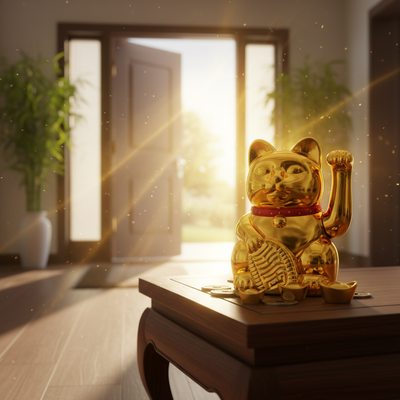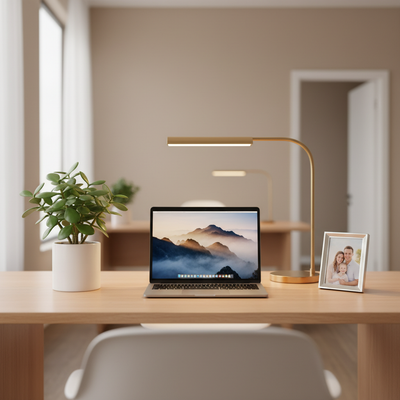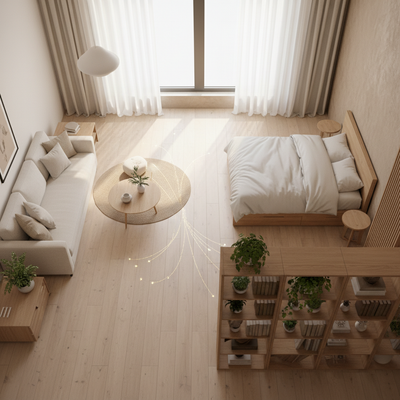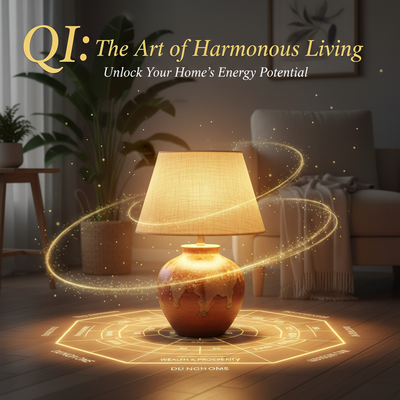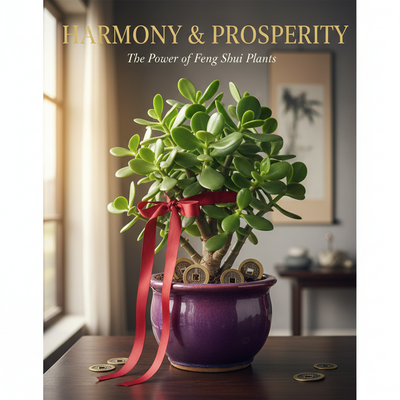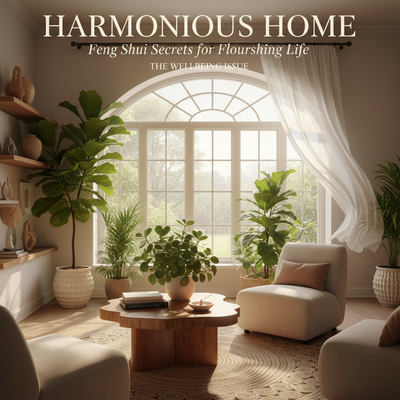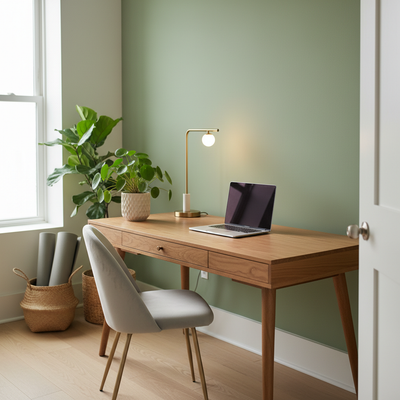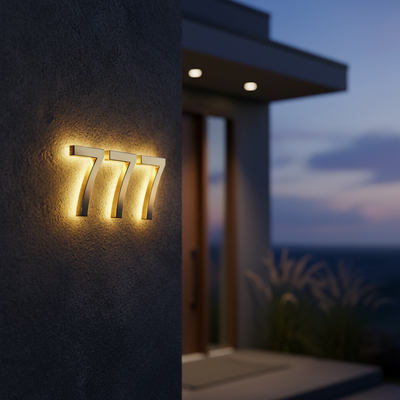A Quick Guide to Balance
What are the best feng shui kitchen colors? The answer is beautifully simple: the ideal colors depend on the energy you want to create. Your kitchen is the energy center of your home—a place for health, food, and wealth. The colors you choose are not just for decoration; they are powerful tools that affect the flow of Chi (life energy) in this important space.
For a balanced and healthy Feng Shui kitchen, focus on earth colors (yellows, beiges), whites, and soft greens. These colors help create stability, cleanliness, and healthy energy.
This guide will go beyond simple lists. We will explore the basic principles of the Five Elements, create smart color combinations, and walk through a step-by-step process to select the perfect feng shui cocina colores for your unique home. By the end, you will have the confidence to design a kitchen that is not only beautiful but also a source of harmony and abundance.
Understanding The Five Elements
To master kitchen color Feng Shui, we must first understand its building blocks: the Five Elements. These are Wood, Fire, Earth, Metal, and Water. Every color, material, and shape connects to one of these elements. How they interact, controlled by two key cycles, determines the energy harmony of a space.
The Productive Cycle describes how elements create and feed one another in a smooth flow. Understanding this cycle is key to layering colors effectively.
- Water feeds -> Wood
- Wood fuels -> Fire
- Fire creates ash -> Earth
- Earth contains -> Metal
- Metal holds -> Water
The Controlling Cycle describes how elements balance and control one another. This is important for fixing energy imbalances. For example, Water puts out Fire, and Fire melts Metal. In the kitchen, we aim for the Productive Cycle to be strongest, using the Controlling Cycle only for specific, small adjustments.
Here is a breakdown of each element and its role in the kitchen:
-
Wood Element
- Energy: Represents growth, life, family, and health. It is an upward, expanding energy.
- Associated Colors: All shades of green and natural browns.
- In the Kitchen: It connects to fresh ingredients, wooden cabinets, cutting boards, and the idea of a family's well-being growing. It is an excellent choice for encouraging healthy eating habits.
-
Fire Element
- Energy: Represents passion, fame, recognition, and high energy. It is the most Yang element.
- Associated Colors: Reds, strong oranges, bright purples, and hot pinks.
- In the Kitchen: The kitchen is already a high-Fire area due to the stove, oven, and microwave. We rarely need to add more Fire colors.
-
Earth Element
- Energy: Represents stability, grounding, nourishment, and self-care. It creates a feeling of being centered and supported.
- Associated Colors: Light yellows, beiges, sandy tones, and earthy browns.
- In the Kitchen: This is arguably the most important element for a kitchen. It helps with good digestion, social connection around food, and a stable, caring environment.
-
Metal Element
- Energy: Represents precision, clarity, efficiency, and purity. It encourages order and focus.
- Associated Colors: White, gray, and all metallic finishes (gold, silver, chrome).
- In the Kitchen: Metal brings a sense of cleanliness and order. It's perfect for creating a bright, efficient workspace. It relates to knives, sinks, and modern appliances.
-
Water Element
- Energy: Represents flow, communication, wisdom, and calm. It has a downward, flowing energy.
- Associated Colors: Black and all shades of blue.
- In the Kitchen: The Water element is present through the sink. Like Fire, it often requires balancing rather than adding more of its associated colors.
Best Colors for Kitchens
With a basic understanding of the Five Elements, we can now explore the specific colors best suited for creating a harmonious kitchen. These colors are chosen because they support the main functions of the kitchen: nourishment, health, and connection. They work to balance the natural Fire and Water elements already present.
The following table provides a clear, easy reference for the top feng shui cocina colores and their energy properties.
| Color | Element | Energy & Meaning in the Kitchen | Best For... |
|---|---|---|---|
| Yellows (Light) | Earth | Nurturing, stabilizing, sunny mood. Helps with good digestion and social connection. | Creating a happy, central family hub. |
| Beige/Sandy Tones | Earth | Grounding, stable, reliable. Creates a calm and dependable foundation. | Balancing a chaotic space; promoting stability. |
| White | Metal | Purity, cleanliness, precision, and focus. Makes space bigger and enhances brightness. | Small kitchens; promoting order and cleanliness. |
| Green | Wood | Health, vitality, growth, and renewal. Connects to nature and fresh ingredients. | Promoting healthy eating and family well-being. |
| Blue (Light) | Water | Calmness, communication, and flow. Can be used sparingly to cool down Fire energy. | Kitchens that feel too "hot" or chaotic. |
| Gray | Metal | Sophistication, neutrality, and calm. A modern choice that supports the Metal element's clarity. | Modern looks; balancing brighter colors. |
Expanding on this, it's the shade that matters. For yellows, choose soft, buttery, or pale straw colors. These Earth tones are gentle and caring, unlike a harsh, bright lemon yellow which can create anxiety. They are wonderful for walls in a kitchen that serves as a family gathering spot.
Beige and sandy tones are the ultimate grounding force. If your family life feels hectic, painting cabinets or walls in a warm beige or taupe can bring a deep sense of calm and stability. These colors provide a solid, reliable foundation upon which to build family life.
White is a Feng Shui powerhouse for kitchens. It means purity and cleanliness, which are most important in a space where food is prepared. It also has the ability to make small kitchens feel larger and more open. An all-white kitchen, however, can feel cold. The key is to balance it with other elements, like a wooden butcher block (Wood) or terracotta herb pots (Earth).
Green is the color of life, health, and renewal. Using shades of sage, mint, or olive green connects your kitchen directly to the energy of fresh produce and vitality. It's an excellent choice for a backsplash, accent wall, or even cabinets to constantly remind you of healthy choices and growth.
While dark blue is not recommended, light, airy blues can be used carefully. A pale sky blue can bring a sense of calm and freshness, helping to cool down the intense Fire energy from the stove. Use it sparingly, perhaps on a small accent wall farthest from the stove.
Gray, a Metal element color, offers a modern and sophisticated alternative to white. A soft dove gray can provide clarity and calmness without the potential coldness of pure white. It pairs beautifully with wood tones (Wood) and metallic hardware (Metal), creating a stylish and balanced space.
Creating a Harmonious Palette
A truly masterful Feng Shui kitchen goes beyond a single color. It involves skillfully blending a palette of colors and materials that work together in harmony. This is where we apply the Five Element cycles to create a space that is both visually stunning and energetically balanced. We use a simple "Base, Accent, and Detail" strategy.
The Base Color sets the main energy for the space. This is your main color, often used on the largest surfaces like walls or cabinets. This color should reflect the primary goal you have for your kitchen. If your goal is stability and family connection, your base color should belong to the Earth element (beige, soft yellow). If your goal is health and vitality, choose a Wood element color (soft green).
The Accent Color supports and feeds your base color, chosen using the Productive Cycle. This creates an energy flow and adds visual depth. Your accent color might appear on a backsplash, an island, countertops, or a feature wall.
- If your Base is Earth (beige walls), your Accent could be Metal (white countertops, gray backsplash) because Earth produces Metal. This creates a stable and clean environment.
- If your Base is Wood (sage green cabinets), your Accent could be a touch of the Water element (a dark blue vase, deep blue dishes) because Water nourishes Wood. This enhances the vitality of the space.
- If your Base is Metal (white cabinets), your Accent could be Earth (a warm, sandy-colored floor or butcher block countertop) because Earth produces Metal. This adds warmth and stability to a clean, precise space.
The Detail or Balancing Touch is the final layer. This involves using a small amount of an element to fix a potential conflict or add a final energy touch. This is often achieved through accessories like plants, utensils, or small appliances. The most common conflict in a kitchen is between the Fire of the stove and the Water of the sink. Placing a Wood element between them—like a green plant, a wooden utensil holder, or a green floor mat—can solve this. The energy flows from Water to Wood to Fire, turning a clash into a productive cycle.
Let's look at some examples:
Scenario 1: The Health-Focused Kitchen.
* Base: Soft green (Wood) on the cabinets to promote vitality.
* Accent: Natural wood tones (Wood) for the countertops and open shelving to double down on growth energy.
* Details: White subway tile backsplash (Metal) for cleanliness and precision. The Metal element controls Wood, so this adds a nice structural balance, keeping the growth energy from becoming chaotic. Add stainless steel (Metal) appliances.
Scenario 2: The Social Hub Kitchen.
* Base: Warm beige (Earth) on the walls to create a nurturing, social atmosphere.
* Accent: White or light gray (Metal) for the cabinets and countertops. Earth produces Metal, so this combination feels stable, clean, and harmonious.
* Details: Terracotta herb pots on the windowsill (Earth) to enhance the grounding energy. A bowl of yellow lemons (Earth) on the counter adds a pop of happy color.
By thinking in terms of Base, Accent, and Detail, you move from simply painting a room to creating an energy symphony.
Applying Colors to Your Kitchen
Now, let's walk through the exact process we use to determine the best colors for a kitchen. This is a practical workshop to translate theory into action. Grab a notepad, and let's analyze your space together to find the perfect feng shui cocina colores for you.
Step 1: Identify Your Kitchen's Bagua Area.
The Bagua is the energy map of your home. It's an octagon divided into nine areas, or "guas," each corresponding to a different aspect of life, an element, and a compass direction. To find your kitchen's location, you'll need a basic floor plan of your home. Stand at your front door looking in and overlay the Bagua map onto your floor plan. (Alternatively, you can use a compass to find the true directions). Identifying which gua your kitchen falls into gives you a powerful starting point for color selection.
Step 2: Choose Colors Based on Direction.
Once you know your kitchen's Bagua location, you can choose colors that enhance the energy of that specific area.
-
East (Health & Family): The element here is Wood. Ideal colors are all shades of green and brown. You can also use supporting Water colors like blue and black as accents. This is a fantastic location for a kitchen, and a green color scheme will amplify its positive health benefits.
-
Southeast (Wealth & Abundance): Also a Wood element area. Greens and browns are excellent. To activate the wealth aspect, you can also add touches of blue (Water element to nourish Wood) and even a small accent of purple or gold.
-
South (Fame & Reputation): This is the Fire element area. Caution is key here. The kitchen already has strong Fire energy from the stove. Adding more Fire with red or orange walls can lead to burnout and arguments. The best strategy is to balance the Fire with strong Earth element colors like soft yellows, sandy beiges, and earthy tones.
-
Southwest (Love & Relationships): This is a primary Earth element area. It's a wonderful location for a kitchen. Enhance the nurturing, relationship-building energy with all Earth colors: yellows, beiges, and warm sandy tones. You can add Fire accents (a red tea kettle) to support the Earth element.
-
West (Children & Creativity): The element is Metal. Ideal colors are whites, grays, and metallics. This promotes precision, joy, and creativity. Support this with Earth tones (as Earth produces Metal). A white and gray kitchen with a warm, earthy-toned floor would be perfect here.
-
Northwest (Helpful People & Travel): Also a Metal element area. Whites, grays, and metallics are best. This placement supports the head of the household. A clean, organized kitchen with these colors fosters clarity and support from the outside world.
-
North (Career & Life Path): The element is Water. This can be a challenging location for a kitchen because it puts the Fire of the stove in direct conflict with the area's primary Water energy. Avoid adding more Water colors (black, dark blue). Instead, use the Wood element (greens, browns) to mediate the conflict (Water nourishes Wood, which fuels Fire). Green is the hero color for a North kitchen.
-
Northeast (Knowledge & Self-Cultivation): An Earth element area. Use earthy tones like beige and sand, but you can also incorporate Fire colors (red, orange accents) as Fire produces Earth, stimulating learning and wisdom.
-
Center (Health & Unity): The heart of the home, this is the Earth element area. Like the Southwest, this is a superb location for a kitchen. Use yellows, beiges, and all earthy colors to promote overall well-being and family unity.
Step 3: Consider Existing "Fixed" Elements.
Look at the elements you can't easily change: your countertops, flooring, cabinet color, and major appliances. Identify their color and corresponding element. Your new paint color should work in harmony with these fixed items. For example, if you have black granite countertops (a strong Water element), you must avoid painting the walls red (Fire), as this creates a direct Water-Fire clash that drains the home's energy. Instead, a much better choice would be a soft green (Wood) for the walls. The Water of the counters would nourish the Wood of the walls, creating a productive, harmonious flow. If you have warm oak cabinets (Wood), painting the walls a soft, earthy beige (Earth) would be a good choice, but avoid a lot of Metal gray, as Metal chops Wood in the controlling cycle.
Colors to Use with Caution
In Feng Shui, no color is naturally "bad." However, some colors carry such powerful energy that they must be used with extreme care in the kitchen, a space already buzzing with potent forces. Misusing these colors can disrupt harmony and create energy stress.
-
Red and Strong Oranges (Fire Element)
- The Issue: The kitchen is the domain of the stove and oven, which are powerful sources of Fire energy. Adding large areas of red—like walls, cabinets, or a large backsplash—supercharges this Fire element. Excess Fire can show up as arguments, anxiety, burnout, or even a higher risk of accidents like fires and cuts.
- The Solution: If you love red, use it as a small, deliberate accent. A red kettle, a bowl of red apples, a piece of art with red in it, or red dishtowels can add a pop of passion without overwhelming the space. Importantly, place these red accents away from the stove to avoid "feeding the fire."
-
Black and Dark Blues (Water Element)
- The Issue: The sink introduces the Water element into the kitchen. The most common and disruptive energy problem in kitchen design is a "Fire-Water clash," which occurs when the stove (Fire) and sink (Water) are directly opposite or next to each other. Using large amounts of black or dark blue, especially on surfaces like countertops, floors, or a backsplash, dramatically increases the Water energy and intensifies this clash. This conflict can drain the household's wealth and health energy.
- The Solution: Avoid using black or dark blue for large surfaces. If you have inherited a kitchen with black countertops, the key is to mediate the clash. Place a Wood element between the sink and stove. A sturdy wooden cutting board, a vase of fresh green herbs, or even a green floor mat can act as a bridge, creating the productive Water -> Wood -> Fire cycle and resolving the conflict.
-
An All-White, Sterile Kitchen (Too much Metal)
- The Issue: White is excellent for cleanliness and purity (Metal element). However, a kitchen that is exclusively white—white cabinets, white walls, white countertops, and stainless steel appliances—can have an excess of Metal energy. This can make the space feel cold, clinical, sterile, and unwelcoming. A kitchen should be nourishing, not surgical.
- The Solution: Warm it up and ground it. The easiest way to balance an all-white kitchen is by introducing Earth and Wood elements. Lay down a warm, earthy-toned rug (Earth). Display wooden utensils in a crock (Wood). Place terracotta pots with herbs on the windowsill (Earth). A large wooden fruit bowl on the counter (Wood) can instantly add life and warmth, balancing the cool precision of the Metal.
Checklist & Final Thoughts
Creating an energetically aligned kitchen is a journey of intention. By applying these principles, you are actively shaping a space that will support and nourish you and your family. Use this final checklist to guide your planning.
My Feng Shui Kitchen Color Plan:
* [ ] I have identified my kitchen's Bagua location.
* [ ] I have chosen a primary color based on the desired energy (Earth for stability, Wood for health, etc.).
* [ ] I have chosen a supporting accent color using the Productive Cycle.
* [ ] I have considered balancing the existing Fire (stove) and Water (sink) elements.
* [ ] I am avoiding large areas of conflicting colors like red or black.
* [ ] I will add natural elements (plants, wood, stone) to complete the space.
Ultimately, the goal of choosing feng shui cocina colores is to create a kitchen that feels wonderful to be in. These principles are powerful guides, but your intuition is also an important tool. Trust the colors that make you feel calm, happy, and healthy. By combining ancient wisdom with your personal taste, you will create a kitchen that is truly the heart of your home—a place of joy, health, and abundance for years to come.
